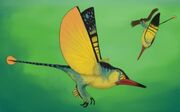
The forest flish (Papilioichthyopteryx irisus) is a small species of flish that originally did not exist, but has since been created by SciiFii and introduced to the rainforests, swamps, forests, and open woodlands across Eurasia and North America to help boost biodiversity. It is only 10 centimeters or so long. In the gloom of the branches and trailing curtains of the trees, forest flish, appearing as bright little jewels, flit about. They are brightly colored like butterflies, but they dart like wrens and beat their wings almost like hummingbirds. Like their marine cousins, ocean flish, forest flish fly by means of an expanded pair of pectoral fins. The fins beat at a blurry 30 cycles per second, allowing them to hover and feed, mostly on insects. When roosting, these flish hang upside-down beneath the branches, clinging on by pelvic fins modified to form hooked claws. Hanging in this way not only provides shelter from the rain, it also makes landing easier. They swoop up to a branch and stall, gripping the branch as they drop. This puts less strain on their pelvic muscles, which would otherwise absorb the impact of landing. The song of the forest flish, which resounds through the environments it lives in as the downpour lessens, is more like the shrill grating of a grasshopper than the fluid notes of a bird. It is produced by stroking together the "teeth" on what remains of the gill arches in the throat. The chirruping sound is amplified by a membrane where the gills used to be. Parts of the gills have also been modified to become ears. The forest flish is a social flock-dwelling animal that lives in groups often containing up to around 30 individuals at a time. The conservation status of the forest flish Least Concern due to successful conservation efforts, the forest flish's wide range, and its tolerance to most of the human activities, including being able to adapt to life in the cities and suburbs.
